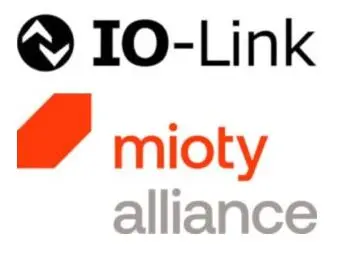

The IO-Link community and the mioty alliance have created a joint working group focusing on the adaptation of IO-Link (IODD) data models and their seamless integration into the mioty standard. The aim of this alliance is to enable low- power wide-area network (LPWAN) technologies for industrial IO-Link applications. The tight integration of software tools, including device on-boarding and the holistic system architecture of the IODD, aims for maximum compatibility.
power wide-area network (LPWAN) technologies for industrial IO-Link applications. The tight integration of software tools, including device on-boarding and the holistic system architecture of the IODD, aims for maximum compatibility.
The combination of IO-Link, which originated in the field of industrial automation on the OT (operational technology) level, and mioty technology, which has its roots in smart cities, smart buildings and smart metering, is in pursuit of what’s viewed as a unique opportunity to build a holistic bridge between these worlds and transfer relevant data from the OT level to higher-level IT systems. The use of mioty wireless technology makes it possible to implement new applications in the industrial environment that were previously impossible due either to cost or feasibility. The use of easily accessible and tried-and-tested system architectures and security concepts from the IoT environment is opening up major opportunities for establishing similar systems in the OT realm, including for the Industrial Internet of Things (IIoT).
mioty is a software based, non-deterministic LPWAN protocol for long range, low power wireless applications that was developed for querying a large number of IoT nodes for condition monitoring over large distances. The advantages of this new wireless technology lie in its high reliability and scalability, in particular in the smart city and smart building sectors where there are a large number of terminals. Using telegram-splitting technology defined by the European Telecommunication Standards Institute (ETSI TS 103 357), data is transferred in multiple packets at different times and frequencies, thereby ensuring high interference immunity and extremely low current consumption.
IO-Link is a globally standardized, deterministic, short-range bidirectional communication technology (IEC 61131-9) used with industrial sensors and actuators. Even the simplest sensors and actuators can be integrated into any fieldbus system without major effort. IO-Link encompasses more than 22,000 different products with more than 36 million nodes installed around the world.
The partnership between the IO-Link community and the mioty alliance aims to seamlessly integrate the mioty technology into the world of IO-Link, thereby creating an expanded solution landscape for applications. A plug and play approach makes it possible to work with devices right away without time-consuming configurations. For members of the mioty alliance, the description of specific sensor data—the so-called payload—via the IODD, the description logic of IO-Link for the payload, is said to offer significant advantages over conventional LPWAN technologies, thereby simplifying the integration of new sensors into existing systems.
IO-Link members are intended to benefit from new cable-free transmission technology that enables reliable and energy-efficient data transfer over large distances. A uniform description file based on the IODD which extends beyond the current world of IO-Link is intended to open the door to previously impossible applications, while at the same time a hundred thousand sensors can be seamlessly integrated into a network without negatively affecting the performance of other wireless systems like WLAN.

